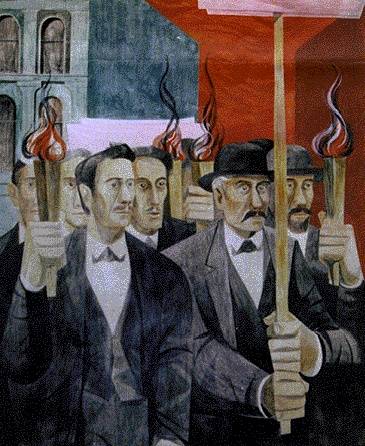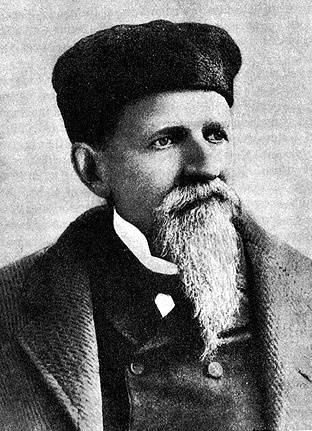Eight hour day movement: Difference between revisions
(new page) |
(categories and links) |
||
| Line 21: | Line 21: | ||
''--Chris Carlsson | ''--Chris Carlsson | ||
[[Local 2 and the Alliance of Rank and File|Prev. Document]] [[The Workingmen’s Party & The Dennis Kearney Agitation|Next Document]] | |||
[[category:Labor]] [[category:1860s]] [[category:1870s]] | |||
Revision as of 12:21, 7 August 2008
Workers march in 1867, celebrating the achievement of the 8-hour day. This rendition in a Rincon Annex mural by Anton Refregier caused a political controversy, forcing the artist to remove the protest sign.
The 8-Hour movement took hold in San Francisco after Alexander M. Kenaday, newly elected president of the Trades' Union in 1865, appealed for the 8-hour day in his inaugural speech. (He had earlier founded The Journal of Trades and Workingmen, but it folded after five issues.)
Alexander Kenaday, president of the Trades' Union in 1865, called for an 8 hour day.
Eight-Hour Leagues sprang up among every kind of unionized worker over the next two years. The most common practice was for a union to meet and adopt resolutions fixing a certain date after which its members would work but eight hours a day. By June 2, 1867, the Morning Call wrote: “the eight-hour system is more in vogue in this city than in any other part of the world, although there are no laws to enforce it.”
The next day, on June 3, a march of over 2,000 workingmen swamped Market Street. They marched in order based on the dates upon which their union had adopted the eight-hour day. The ship and steamboat joiners led, followed by plasterers, bricklayers, hodcarriers, stonecutters, lathers, riggers, gas fitters, house carpenters and painters. The parade ended at Union Square where several speeches were made, including anti-Chinese diatribes, sentiments which became more powerful during the next decade.
In the summer and fall of 1867, the employers along the waterfront made a determined effort to abolish the eight-hour day. On July 8, the Pacific Mail Steamship Company discharged all its employees who had been working an eight hour day. That same day a number of owners formed the Ten-Hour Association, which in turn created the “Ten-Hour League Society” for the purpose of uniting all mechanics “willing to work at the old rates, neither unjust to the laborers nor ruinous to the capital and enterprise of the city and state, together with all Master Builders and Master Workmen and Capitalists injured by the Eight-Hour rule.” But their effort soon failed.
On December 3, 1867, the San Francisco Board of Supervisors passed an 8-hour ordinance covering all employed by the city. By February 1868 there were at least twenty-five 8-Hour Leagues in San Francisco, and on February 22, 1868, a march of thousands in San Francisco celebrated the passage of a state-wide 8-hour law. Again they marched in order by when they began working 8-hour days: ship caulkers (Dec. 1865), shipwrights (Dec 1865), ship joiners (Jan 1866), ship painters (March 1866), plasterers (Aug 1866), bricklayers (Feb 1867), Laborer's Protective Benevolent Association (Feb 1867), stone masons (Mar 1867), stonecutters and marble polishers (May 1867), lathers (May 1867), riggers (June 1867), metal roofers (June 1867), house painters (June 1867), plumbers and gas fitters (July 1867), and the machinists, ironworkers, brass finishers, and their apprentices, not then working eight hours.
In 1868 and 1870, San Francisco employers brought in workers from the east to break the 8-hour day in San Francisco. Advertisements by the California Labor and Employment Exchange, a bureau supported by employers to find cheap labor, attracted many immigrants to California. The conclusion of the Civil War and the industrial depression in the east sent many packing westward. When the transcontinental railroad opened up in 1869, the workers who built it were unemployed too. With this influx of desperate, unemployed people, the 8 hour day soon gave way to harsher conditions once more. By 1872 few workers held to the 8-hour day, although bricklayers and plasterers held out until the late 1870s.
--Chris Carlsson


